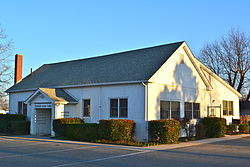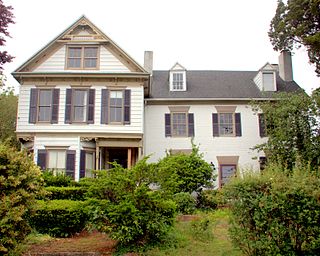
Laurel is a town in Sussex County, Delaware, United States. The population was 3,708 at the time of the 2010 census. Laurel is part of the Salisbury, Maryland-Delaware Metropolitan Statistical Area. It once hosted the Laurel Blue Hens of the Eastern Shore Baseball League.
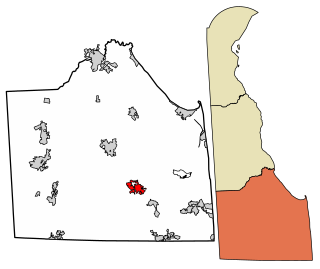
Millsboro is a town in Sussex County, Delaware, United States. Millsboro is part of the Salisbury metropolitan area.

Seaford is a city located along the Nanticoke River in Sussex County, Delaware, United States. According to the 2010 Census Bureau figures, the population of the city is 6,928, an increase of 3.4% from the 2000 census. It is part of the Salisbury, Maryland-Delaware Metropolitan Statistical Area.

Dwight Presbyterian Mission was one of the first American missions to the Native Americans. It was established near present-day Russellville, Arkansas in 1820 to serve the Arkansas Cherokees. After the Cherokee were required to move to Indian Territory in 1828, the mission was reestablished in 1829 near present-day Marble City, Oklahoma. The mission is listed on the National Register of Historic Places.
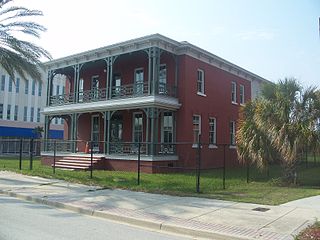
The Brewster Hospital building is a historic U.S. hospital in the LaVilla neighborhood of Jacksonville, Florida. It was located at 915 West Monroe Street. On May 13, 1976, the building was added to the U.S. National Register of Historic Places. In 2005, it was moved across the street to 843 West Monroe Street.
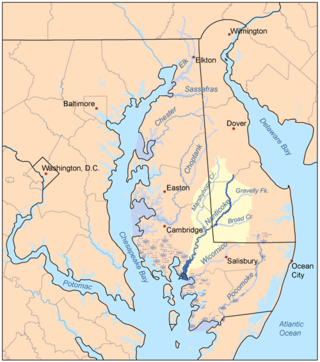
The Nanticoke people are a Native American Algonquian people, whose traditional homelands are in Chesapeake Bay and Delaware. Today they live in the Northeastern United States and Canada, especially Delaware; in Ontario; and in Oklahoma.

Bacone College, formerly Bacone Indian University, is a private college in Muskogee, Oklahoma. Founded in 1880 as the Indian University by missionary Almon C. Bacone, it was originally affiliated with the mission arm of what is now American Baptist Churches USA. Renamed as Bacone College in the early 20th century, it is the oldest continuously operated institution of higher education in Oklahoma. The liberal arts college has had strong historic ties to several tribal nations, including the Muscogee and Cherokee. The Bacone College Historic District has been on the National Register of Historic Places listings in Muskogee County, Oklahoma since 2014.

Fort Totten State Historic Site is a historic fort that sits on the shores of Devils Lake near Fort Totten, North Dakota. During its 13 years of operation as a fort, Fort Totten was used during the American Indian Wars to enforce the peace among local Native American tribes and to protect transportation routes. After its closing in 1890, it operated until 1959 as a Native American boarding school, called the Fort Totten Indian Industrial School. It was added to the National Register of Historic Places in 1971; in its nomination form, the State Historical Society of North Dakota called it "one of the best preserved military posts... in the Trans-Mississippi West for the Indian Wars period".
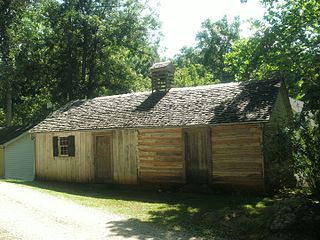
Bear Mountain Indian Mission School is a historic Native American missionary school in Amherst, Virginia.

Harmony Church is a historic Methodist Episcopal church located at Millsboro, Sussex County, Delaware. It was built in 1891, and is a one-story, wood-frame building covered with asbestos siding and in the Late Gothic Revival style. It has a two-story wing and sits on a rock-faced, concrete block foundation. It features a two-story crenellated tower. The congregation was organized in 1818. The Indian Mission Church of the Nanticoke Indian Association was formed from Harmony Church after the hiring of an African American minister.

Indian Mission Church is a historic Methodist church located in Millsboro, Sussex County, Delaware. It was built in 1921, and is a one-story, wood-frame building covered with clapboard siding and in the Late Gothic Revival style. It features a two-story hipped roof tower and lancet windows. The congregation was organized in 1881 from the Harmony Church after the strongly Native American families of the Nanticoke Indian Association separated after the hiring of an African American minister.

The Phoenix Indian School, or Phoenix Indian High School in its later years, was a Bureau of Indian Affairs-operated school in Encanto Village, in the heart of Phoenix, Arizona. It served lower grades also from 1891 to 1935, and then served as a high school thereafter. It opened in 1891 and closed in 1990 on the orders of the federal government. During its existence, it was the only non-reservation BIA school in Arizona.

Shoshone-Episcopal Mission is a historic mission and school in Fort Washakie, Wyoming. The school was built from 1889 to 1890 by Rev. John Roberts, the minister and teacher on the Wind River Indian Reservation. Roberts built the boarding school to teach the Shoshone girls living on the reservation; as many of the students lived up to 20 miles (32 km) away from the school, it was necessary to build a boarding school to teach them. The school later became the headquarters of the entire Episcopal mission on the reservation.

The Tanana Mission was a historic Episcopal church mission in Tanana, Alaska. Its abandoned church building and cemetery are listed on the U.S. National Register of Historic Places.
Mardock Mission was a historic meetinghouse built in 1898 in Mardock, Oklahoma. The mission was listed in the National Register of Historic Places in 1983 for its significance as the only remaining building associated with the Big Jim Band of Absentee Shawnee Indians, the Quaker Missionaries, and a pre-World War I socialist movement. The Absentee Shawnee were so named because in 1845 they had left the rest of the tribe in Kansas and settled along the Canadian River in Indian Territory. Big Jim, (Wapameepto), grandson of Tecumseh, was the chief of the Kispicotha, better known as the Absentee Shawnee. The group numbered 454 in 1904.

Harmon School, also known as Warwick No. 225, is a historic rural school building located near Millsboro, Sussex County, Delaware. It was built in the early 1920s, and is a one-story, frame structure with wood shingles in the Colonial Revival style. It sits on a concrete foundation and has a gable roof and large, square brick central chimney. The front facade features a central pedimented portico with four square columns and two square pilasters. The Harmon School was originally formed to be used exclusively for Nanticoke Indian Association students until after the new school was constructed in the 1920s. The introduction of African American teachers and students caused the Indian students to withdraw and form the Indian Mission School.
Ames Hitchens Chicken Farm was a historic home and farm located near Millsboro, Sussex County, Delaware. It included a two-story, wood frame, gable front dwelling and two long, one-story, flatroofed buildings, used as chicken houses. It was the last of these structures still standing within the Indian River Nanticoke Indian Association community.

The McKinley Park School, at Riverside Drive and Keystone Avenue in Reno, Nevada, USA, is a historic school building that was built in 1909. It includes Mission/Spanish Revival architecture and was designed by George Ferris. Also known as the City of Reno, Recreation Center, it was listed on the National Register of Historic Places in 1985.

Hughes A.M.E. Chapel, also known as the Trinity Methodist Episcopal Church and the Nause-Waiwash Longhouse, is a historic building located near Cambridge in Dorchester County, Maryland, United States. It is a simple rectangular frame structure, three bays in length, with a medium-pitched gable roof. The exterior is covered with weatherboard siding and the windows are covered with shutters. The former church building is a common example of late 19th- and early 20th-century religious buildings that were built in rural communities on the Eastern Shore of Maryland. It was located in the Bucktown area, which was home to bi- and tri-racial people who were descended from Native, African, and European Americans. The building has been occupied throughout its existence by members of the local community, including by the Nause-Waiwash Band of Indians, a non-profit organization for people who self-identify as being of Nanticoke descent. The Nause-Waiwash Band of Indians acquired the building in 1998. It was listed on the National Register of Historic Places in 2018.
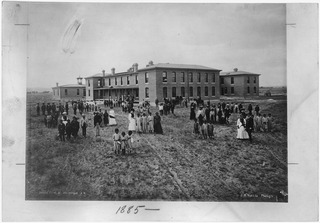
Albuquerque Indian School (AIS) was a Native American boarding school in Albuquerque, New Mexico, which operated from 1881 to 1981. It was one of the oldest and largest off-reservation boarding schools in the United States. For most of its history it was run by the Bureau of Indian Affairs (BIA). Like other government boarding schools, AIS was modeled after the Carlisle Indian Industrial School, using strict military-style discipline to strip students of their native identity and assimilate them into white American culture. The curriculum focused on literacy and vocational skills, with field work components on farms or railroads for boys and as domestic help for girls. In the 1930s, as the philosophy around Indian education changed, the school shifted away from the military approach and offered more training in traditional crafts like pottery, weaving, and silversmithing.
